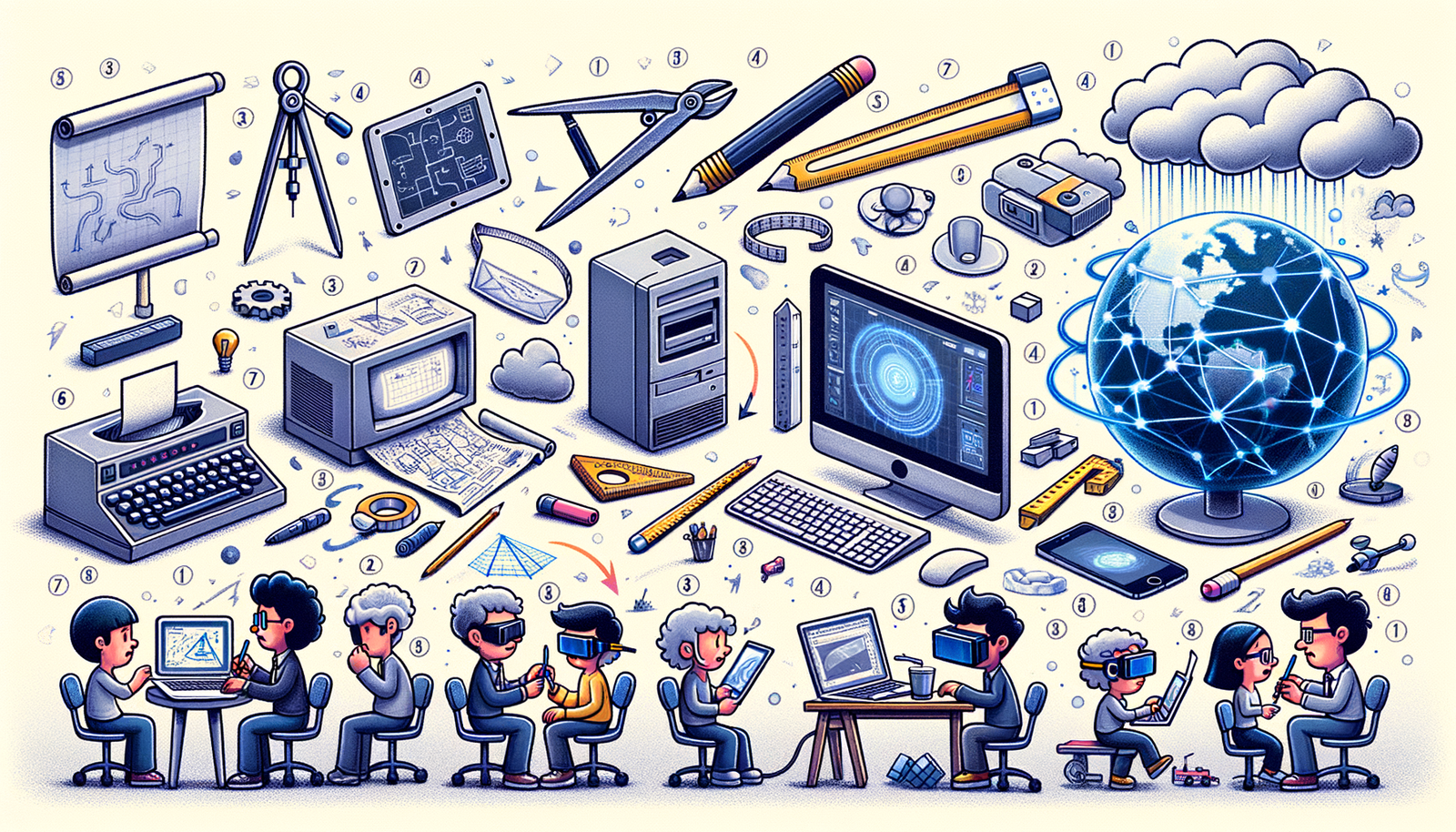Your Cart is Empty
Customer Testimonials
-
"Great customer service. The folks at Novedge were super helpful in navigating a somewhat complicated order including software upgrades and serial numbers in various stages of inactivity. They were friendly and helpful throughout the process.."
Ruben Ruckmark
"Quick & very helpful. We have been using Novedge for years and are very happy with their quick service when we need to make a purchase and excellent support resolving any issues."
Will Woodson
"Scott is the best. He reminds me about subscriptions dates, guides me in the correct direction for updates. He always responds promptly to me. He is literally the reason I continue to work with Novedge and will do so in the future."
Edward Mchugh
"Calvin Lok is “the man”. After my purchase of Sketchup 2021, he called me and provided step-by-step instructions to ease me through difficulties I was having with the setup of my new software."
Mike Borzage
Design Software History: The Evolution of Real-Time Collaboration in CAD: Transforming Design Processes Through Cloud Technologies and Advanced Communication Tools
January 14, 2025 9 min read


Introduction to Real-Time Collaboration in CAD
In the rapidly evolving landscape of modern design and engineering, Computer-Aided Design (CAD) stands as a cornerstone technology, revolutionizing how professionals conceptualize and realize products and structures. From intricate mechanical components to complex architectural marvels, CAD software has empowered designers and engineers to create with unprecedented precision and efficiency. The significance of CAD lies in its ability to transform imaginative ideas into detailed digital models, enabling simulations, analyses, and optimizations that were once unimaginable. As the global work environment becomes increasingly interconnected, the need for real-time collaboration has emerged as a critical factor in driving innovation and productivity. Traditional design workflows, often constrained by sequential processes and geographical limitations, are giving way to dynamic, collaborative models. Real-time collaboration in CAD allows multiple stakeholders to work simultaneously on the same project, fostering immediate communication and swift decision-making. This shift is not just about technological advancement but also about embracing a more integrated approach to problem-solving in a globally connected world. The journey toward real-time collaboration in CAD has been marked by significant milestones and technological progress. Initially, collaboration was limited to basic methods such as exchanging design files via email, leading to challenges like version control issues and communication delays. However, with the advent of advanced collaboration tools and the integration of cloud computing, the landscape has dramatically changed. The evolution of these tools has paved the way for features that enable designers and engineers to collaborate in real-time, breaking down barriers and setting new standards for efficiency and innovation in the field of design and engineering.
Historical Development and Milestones
The evolution of collaborative tools in CAD software has been a progressive journey, rooted in the necessity to enhance communication and efficiency among design teams. In the early stages, collaboration was primarily facilitated through the exchange of design files via email or physical storage media like floppy disks and CDs. This method was fraught with challenges, including version control problems, data redundancy, and significant delays in the design process. Teams often grappled with the complexities of merging changes from multiple contributors, leading to inconsistencies and errors in the final designs. Recognizing these challenges, pioneering companies like Autodesk took significant steps to integrate collaborative features into their software. Autodesk's AutoCAD, one of the most widely used CAD programs, began incorporating functionalities that allowed for better management of shared files. Features like external references (xrefs) enabled users to link drawings together, facilitating a form of collaboration where changes in one file could be reflected in others. This was a crucial development that helped teams maintain consistency across complex projects. Other industry leaders also contributed to early collaborative efforts. For instance, Bentley Systems introduced ProjectWise, a system designed to manage and share engineering project content. While these tools improved collaboration to an extent, they primarily operated on a check-in/check-out basis, where only one user could edit a file at a time. This approach still limited simultaneous collaboration and required robust communication protocols to ensure team members were not working on outdated versions.
The Shift to Real-Time Collaborations
The transition to real-time collaboration in CAD was propelled by technological advancements such as increased internet bandwidth and the emergence of cloud computing. These innovations provided the necessary infrastructure for multiple users to work on the same files concurrently, regardless of their physical locations. Enhanced internet capabilities allowed for larger files to be transferred and accessed quickly, eliminating the latency issues that previously hindered collaborative efforts. Influential software pioneers recognized the potential of these technologies. PTC made significant strides with its acquisition of CoCreate in 2007, a platform known for its direct modeling approach and collaborative features. CoCreate allowed designers to make real-time changes without the limitations of a history-based modeling system, which was particularly advantageous for collaboration. Users could work on models simultaneously, with the software managing changes and ensuring that the most recent updates were available to all team members. Similarly, Dassault Systèmes advanced real-time collaboration through its SOLIDWORKS PDM (Product Data Management) system. This tool provided a centralized repository for design data, enabling teams to access and edit files collaboratively. SOLIDWORKS PDM introduced features like version control, workflow automation, and secure access, which were critical in managing collaborative projects efficiently. By integrating these features directly into the CAD environment, Dassault Systèmes empowered design teams to work more cohesively and responsively. The shift to real-time collaboration was not just about technological capability but also about changing the culture of design workflows. It required organizations to adopt new processes and trust in the reliability of cloud-based systems. The efforts of companies like PTC and Dassault Systèmes were instrumental in demonstrating the viability and benefits of real-time collaboration, paving the way for broader adoption across the industry.
Cloud-Based Platforms
The advent of cloud-based platforms marked a significant turning point in CAD collaboration, fundamentally altering how design data is accessed and shared. By leveraging cloud technologies, CAD software transcended the limitations of local computing resources, offering scalable and accessible solutions that enable real-time collaboration on a global scale. The cloud provides a centralized environment where all project data is stored and managed, ensuring consistency and accessibility for all team members. Platforms like Autodesk Fusion 360 have been at the forefront of this transformation. As one of the first cloud-native CAD solutions, Fusion 360 integrates design, engineering, and manufacturing into a single platform. It allows multiple users to collaborate on the same project in real-time, with changes being updated instantaneously. This immediacy facilitates rapid prototyping and iterative design, significantly reducing development cycles. Autodesk's embrace of cloud technology reflects its commitment to innovation and responsiveness to the needs of modern design teams. Similarly, Onshape, founded by industry veterans John McEleney and Jon Hirschtick (former CEOs of SOLIDWORKS), represents a leap forward in collaborative CAD. Onshape is entirely cloud-based and operates through web browsers and mobile applications, eliminating the need for complex installations and hardware dependencies. It offers robust version control and data management features, enabling teams to work concurrently without the risk of overwriting each other's work. Onshape's real-time collaboration tools have empowered companies to streamline their design processes, enhance productivity, and foster innovation. The adoption of cloud-based CAD platforms underscores a shift towards more flexible, accessible, and efficient design environments. Key advantages of cloud-based CAD include:
- Scalability: Adaptable resources to meet varying project demands.
- Accessibility: Access design tools and data from any location, on any device.
- Collaboration: Real-time collaboration with instant synchronization among team members.
- Cost Efficiency: Reduced need for expensive hardware and maintenance.
Advanced Communication Tools
An essential aspect of effective real-time collaboration is the integration of advanced communication tools within CAD software. These tools facilitate seamless interactions among team members, enabling immediate feedback, discussions, and collective problem-solving. By embedding communication features directly into the CAD environment, designers and engineers can collaborate without the disruptions caused by switching between different applications or platforms. Modern CAD solutions have incorporated features like live chat, annotation tools, and collaborative viewing. For instance, Siemens NX offers synchronous collaboration capabilities that allow multiple users to view and edit models simultaneously. Users can see each other's cursor movements and changes in real-time, making cooperative work more intuitive and engaging. These integrated tools enhance transparency and understanding among team members, leading to more cohesive and efficient design processes. In addition to built-in features, CAD software has increasingly integrated with external collaboration platforms like Slack and Microsoft Teams. These integrations enable teams to receive notifications, share updates, and discuss design changes within their preferred communication channels. For example, Autodesk's integration with Microsoft Teams allows users to share design files and view live updates directly within Teams, streamlining the collaboration process. Such integrations bridge the gap between design work and team communication, ensuring that all stakeholders remain informed and engaged. These advancements not only improve communication but also enhance the overall agility of design teams. By facilitating real-time discussions and immediate access to information, teams can make quicker decisions, adapt to changes promptly, and reduce the likelihood of errors. The synergy between CAD software and communication tools represents a significant step forward in creating a truly collaborative and responsive design environment.
Business and Design Impact
The incorporation of real-time collaboration in CAD has had profound effects on both business operations and design methodologies. From a business standpoint, the ability to collaborate instantaneously across geographies and time zones has significantly shortened project timelines. Teams can work concurrently on different aspects of a project, reducing the overall time from conception to completion. This efficiency translates into cost savings and a faster response to market demands, providing a competitive edge in industries where innovation speed is critical. Real-time collaboration also enhances resource management by optimizing the utilization of human capital. By facilitating better communication and coordination, organizations can allocate tasks more effectively, ensuring that expertise is applied where it is most needed. This leads to improved productivity and a reduction in redundant efforts, as team members have immediate visibility into each other's work. In terms of design, real-time collaboration fosters cross-disciplinary cooperation, bringing together professionals from various fields such as engineering, design, marketing, and production. This integrative approach encourages the sharing of diverse perspectives and expertise, leading to more innovative and well-rounded solutions. Designers can receive instant feedback from engineers about the feasibility of certain features, while marketers can provide insights into consumer preferences, all within the same collaborative platform. Industries like architecture, automotive, and consumer electronics have been particularly transformed by these collaborative capabilities. In architecture, for example, collaborative CAD tools enable architects, engineers, and construction managers to work together seamlessly, improving accuracy and reducing the risk of costly errors. In automotive design, real-time collaboration accelerates the development of new models by allowing global teams to contribute simultaneously, integrating complex systems more efficiently. Consumer electronics companies leverage collaborative CAD to innovate rapidly, adapting to fast-changing technology trends and consumer demands. Overall, the impact of real-time collaboration extends beyond operational efficiencies. It has redefined how organizations approach problem-solving and innovation, fostering a culture of collaboration that permeates all levels of the design process. By embracing these collaborative tools, businesses can unlock new potentials for creativity, agility, and market responsiveness.
Emerging Trends
Looking to the future, several emerging trends are poised to further revolutionize real-time collaboration in CAD. One significant development is the integration of Virtual Reality (VR) and Augmented Reality (AR) technologies. VR and AR offer immersive environments where designers and stakeholders can interact with 3D models in a more intuitive and tangible way. This immersive collaboration enhances spatial understanding and allows for real-time modifications in a virtual space, bridging the gap between digital designs and physical experiences. Another transformative trend is the incorporation of Artificial Intelligence (AI) driven design aids. AI algorithms can assist in generating design options, optimizing structures, and predicting performance outcomes. When integrated into collaborative CAD environments, AI can provide real-time suggestions and automate routine tasks, allowing designers to focus on more complex and creative aspects of their work. This synergy between human creativity and machine intelligence opens new avenues for innovation and efficiency. Moreover, the application of blockchain technology for secure design sharing is gaining traction. Blockchain offers a decentralized and immutable ledger system, ensuring that design data is securely shared and tamper-proof. This is particularly valuable in collaborative environments where intellectual property protection and data integrity are paramount. Blockchain can enhance trust among collaborators, facilitate compliance with regulatory requirements, and streamline the validation and approval processes. These technological advancements have significant implications for design education as well. There is a growing emphasis on training the next generation of designers to navigate and leverage these collaborative tools effectively. Educational institutions are integrating cloud-based CAD platforms, VR/AR technologies, and AI applications into their curricula, promoting a hands-on, collaborative learning environment. This prepares students to thrive in modern design settings where teamwork and technological proficiency are essential. Some key emerging trends include:
- Integration of VR/AR Technologies: Providing immersive design experiences for enhanced spatial understanding.
- AI-Driven Design Aids: Assisting in generating and optimizing designs through intelligent algorithms.
- Blockchain for Secure Sharing: Ensuring data security and integrity in collaborative environments.
- Evolution of Design Education: Training designers in advanced collaborative tools and technologies.
Conclusion
The evolution of real-time collaboration in CAD software has fundamentally transformed the landscape of design and engineering. From the early days of basic file exchanges to the sophisticated cloud-based platforms of today, the trajectory reflects a relentless pursuit of efficiency, innovation, and connectivity. Real-time collaboration has broken down geographical barriers, enabling teams around the world to work together seamlessly, accelerating project timelines, and fostering a more integrated and dynamic approach to design. The integration of advanced technologies such as VR/AR, AI, and blockchain promises to further revolutionize collaborative efforts, offering more immersive experiences, intelligent assistance, and secure data management. These advancements not only enhance the capabilities of design professionals but also redefine educational paradigms, preparing future generations to thrive in increasingly collaborative and technologically complex environments. As the industry continues to evolve, there is an ongoing need for adaptable collaboration tools that can respond to emerging challenges and opportunities. Encouraging innovation and research in this area is essential to bridging gaps, whether geographical, disciplinary, or technological. By embracing the transformative potential of real-time collaboration, organizations and individuals alike can unlock new levels of creativity, productivity, and impact, shaping a future where the possibilities for design and engineering are limited only by imagination.
Also in Design News

Cinema 4D Tip: Lock Framing Early with Cinema 4D Safe Frames and Aspect Overlays
October 30, 2025 2 min read
Read More
ZBrush Tip: Conservative Projection Workflow for Artifact-Free Detail Transfer
October 30, 2025 2 min read
Read More
V-Ray Tip: Bake Static GI into Lightmaps for Real-Time Engines
October 30, 2025 2 min read
Read MoreSubscribe
Sign up to get the latest on sales, new releases and more …


